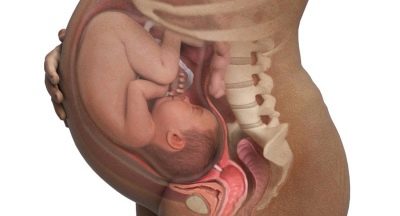At what week of pregnancy does the belly begin to grow and at what month is it very noticeable?
Women who are preparing to become mothers, literally from the first days begin to look more closely at their reflection in the mirror - whether external signs of pregnancy have appeared. These symptoms primarily include the growth of the abdomen. But when to wait for this sign, and how soon people around will be able to guess about the “interesting position” of a woman, you will not understand at once. Let's try to answer this question in as much detail as possible in this article.
Why does a shape change occur?
The belly of a pregnant woman does not begin to grow immediately. An increase in it is a consequence of the growth of the uterus. A non-pregnant uterus has very small dimensions - its volume is only 5 ml, and it weighs about 60-70 grams. With the beginning of the development of her baby, new muscle fibers begin to form, which will allow the body to stretch and grow to become a cozy and reliable "house" for constantly growing crumbs for the next 9 months.
Growth in the first few months is difficult to track outwardly; only by the 8th week of pregnancy the reproductive female organ reaches the size of a goose egg. But the uterus is still in the pelvic cavity, and therefore the stomach does not grow. Intensive growth and stretching of the anterior abdominal wall begins as the height of the uterus increases.
The bottom is the wide part of the uterus, located opposite to the genital tract and the cervix. The height will increase weekly, with the result that the uterus will leave the pelvis and enter the abdominal cavity. It is from this moment that the rapid growth of the abdomen begins. This usually occurs after 15-16 weeks of pregnancy.
But everyone knows that some women do not see the belly almost until delivery, while others have already 4 months forms are rounded, and their position does not cause doubts among others. Why it happens?
First of all, it affects the elasticity of the abdominal wall. For multiparous, it is usually more stretched, and therefore the stomach visually appears earlier than that of nulliparous. With polyhydramnios (exceeding the volume of amniotic fluid), the stomach also grows faster and becomes more noticeable earlier.
It affects the heredity, width of the hips, the number of fruits, the place of attachment of the placenta.
How does the body change by month?
During pregnancy, the uterus increases almost 500 times, but this growth is gradual. The uterus, in order to meet the “demands” of a growing baby, must constantly rise. It is this rise that is called the height of standing of the bottom of the uterus, or in abbreviated form - VSDM. Doctors begin to measure this parameter after 13-14 weeks, when the reproductive organ begins to rise above the pubis, that is, leave the pelvic area.
Measurement of VSDM is not for curiosity, but for diagnostic purposes only, because the growth of the uterus can tell a lot about the specialist.In particular, its excess of normative values may indicate that there is a large baby in the womb or there is plenty of water (ultrasound will answer this question in more detail), and the lagging behind HRMD may be a sign of intrauterine growth retardation.
The measurement is taken from a woman lying on her back, the main unit of measurement is centimeters. For measurement, obstetricians use tazomers or the most common soft measuring tape.
If you look closely at the standard values, the growth of the uterus as a whole almost corresponds to the gestational age in numerical value:
- 8-9 week - VSDM is equal to 8-9 centimeters;
- 10-11 week - 10-11 cm;
- 12-13 a week - 11-12 cm;
- 14-15 weeks - 12-13 cm;
- 16-17 week - 14-18 cm;
- 18-19 week - 16-20 cm;
- 20-21 weeks - 18-22 cm;
- 22-23 week - 21-24 cm;
- 24-25 week - 23-26 cm;
- 26-27 week - 24-28 cm;
- 28-29 week - 27-30 cm;
- 30-31 week - 29-32 cm;
- 32-33 week - 31-33 cm;
- 34-35 week - 32-33 cm;
- 36-37 week - 32-36 cm;
- 38-39 week - 34-37 cm;
- 40 weeks - 34-35 cm.
As you can see, a slight decrease in the growth rate of the uterus is observed only at the end of the third trimester, when the female reproductive organ reaches its maximum size, the stomach drops, the baby assumes the prenatal position, the head is pressed against the exit from the mother's womb.
Usually, after this, it becomes much easier for the woman to breathe (the uterus no longer supports the diaphragm), and the ribs cease to hurt.
And the girth of the abdomen is also measured, but this parameter is very individual - a woman before pregnancy could be thin or obese, she could be tall or short. All this will certainly affect the growth rate of the abdomen and its size. The abdominal circumference is measured only to track the dynamics of a particular woman.
On a note! The thinner a woman was before pregnancy, the higher the likelihood that her stomach will become noticeable earlier. Only women who are obese, overweight and well-built can hide their position for a long time.
If changes are invisible
Often women worry that the belly grows too slowly. The term is already more than 4 months, and the stomach is not visible. There are a variety of guesses, most of which are painted in negative shades. You should not worry, it is quite possible that you have the prerequisites for this. Keep calm and talk to your doctor. If the baby is all right, and he develops according to the gestational age (which is checked by ultrasound), then there is no reason for worry. The stomach may not visually appear or grow too slowly in several cases.
- The woman is trained, sports press - the abdominal wall in this case retains its shape longer.
- Wide hips more often they lead to a slow growth of the abdomen, because the pelvic space is wider, and the uterus can stay there longer. Sooner or later, her exit into the abdominal cavity is bound to happen.
- Location of the placenta. If the placenta is located on the back wall, closer to the back of the expectant mother, the growth of the tummy will begin later than in women with the placenta located on the front wall of the uterus.
- Malovodie. Call this cause normal can not be a complication of pregnancy. With it, the amount of amniotic fluid is less than normal, and the slow growth of the abdomen is the main consequence of this complication.
- Heredity. Daughters in most cases borrow the size of the pelvis and some key constitutional features from mothers, and therefore you should not wait for the early appearance of the tummy to women whose mothers up to 8 months quietly kept their pregnancy secret from others, since it was almost not noticeable.
- Completeness. In obese women due to the presence of fat folds on the abdomen and thighs, the abdomen is outlined later. Until recently, such a woman does not look pregnant and often only at 7-8 months characteristic roundness appears.
- The sequence of pregnancy. During the first pregnancy, a slightly slow growth of the abdomen is a normal phenomenon.Muscles are not stretched, less elastic, and therefore the characteristic tummy, which is difficult to hide under spacious clothing, usually appears only by the end of the second trimester.
Growth too fast
Sometimes you can meet women with a rather noticeable, big belly at the beginning of the second trimester. The reasons for this may be several, and almost none of them should cause concern.
- Narrow hips. If a woman has narrow hips, then the growing uterus very quickly begins to lack space, she goes beyond the pelvis and begins to push the internal organs from their usual place. This feature may be a complication of childbirth, and therefore is an indication for a planned cesarean section, but the baby’s narrow hips of the expectant mother are in no way reflected in the carrying of the baby and his health and well-being.
- Repeated pregnancy. During the second pregnancy, especially if the woman does not play sports and has rather weak abdominal muscles, the stomach appears faster.
- Multiple pregnancy. The uterus, in which 2 or 3 babies develop, grows at a faster rate, and therefore such a pregnancy becomes noticeable earlier, the stomach appears in some already at the end of the third month.
- Many water. Excess amount of amniotic fluid leads to faster growth of the uterus, in connection with which the stomach grows faster.
- Placenta. Its location on the anterior wall of the uterus usually leads to an earlier appearance of the contours of the "pregnant" tummy.
- Body build and weight. In lean and thin, the stomachs are becoming obvious to others. In this case, quite often the characteristic dark strip on the abdomen appears first, and right after this the tummy itself begins to grow.
Pathological causes of abnormalities VSDM
Do not confuse the visual growth rate of the abdomen and quite specific parameter VSDM, which was mentioned above. If the tummy is imperceptible for a long time, in most cases it is not dangerous, but a significant lag or advance in the pace of the height of the uterus can stand talking about pathology.
Important! Deviation of VSDM by itself cannot be a basis for establishing a diagnosis, but may be a reason for appointing a pregnant woman with an additional examination, including ultrasound diagnosis.
VSDM below the norm quite often speaks of a mistakenly determined period of pregnancy. If at the same time ultrasound confirms the normal development of the fetus, and Doppler ultrasound does not reveal any blood flow disturbances in the mother-placenta-fetus system, then the obstetrician is most likely to make a wrong appointment. This happens most often in women with irregular menstrual periods, with irregular menstrual periods, who themselves do not exactly remember the date of their last menstruation. The same problem is often faced by lactating mothers who became pregnant again during the period of GW.
Another reason for the laggards from the norm is low water. In the second and third trimester, the reason for the lag in the height of the bottom of the reproductive female organ may be the incorrect position of the fetus, in which it is located across the uterus or obliquely.
The most dangerous thing that VSDM lagging behind more than 2 centimeters from the norm in terms of time can tell is the delay in the development of a baby. The reasons can be many - from violations of the placenta to intrauterine infection, poor maternal nutrition, and so on. The task of the doctor is to find out the reason, eliminate it, so that the baby can continue to develop normally.
If the height of the bottom of the uterus exceeds the norm by 2 or more centimeters, the doctor may suspect a large fetus. But if mom and dad have a little bit of a crumb, then this is quite normal, because the child inherits their physique, a tendency to growth and fullness.
It is at least ridiculous to talk about VSDM about the probability of multiple pregnancy in our time. Earlier, when there was no ultrasound, it was this measurement that helped the doctor in the second trimester to assume that a woman would become the mother of more than one baby.Later, when the heads of the fruits were felt, their number was determined (sometimes the human factor was mistaken). Today there is an ultrasound scan, and even before the uterus begins to go beyond the pelvic, in 11-13 weeks the woman will undergo first prenatal screeningin the framework of which the doctor will necessarily inform her about how many living and developing children there are in the cavity of the reproductive organ.
Common Questions
With the growth of the abdomen in women is associated with many questions. Let's try to briefly answer the most common.
Is it possible to determine the sex of a child by the shape of a growing belly?
The shape of the abdomen during its intensive growth depends on the body of the woman, on the width of her pelvis, but not on the sex of the fetus. But if you really want to believe that the belly of the “corner” is a boy, and the “ball” is a girl, then please. Unfortunately, popular rumor, which attributes such properties to the form of the abdomen, does not explain how to be a mother of opposite sex - she has a boy and a girl, and for some reason the form of the stomach is one.
What if everyone tries to touch the belly?
Almost all pregnant women face such a problem. As soon as the forms of the abdomen become apparent and noticeable, everyone around them strives to touch it. A woman can be unpleasant such intrusive attention from outsiders. No need to endure and be silent (negative emotions are very harmful).
It is enough to immediately warn those around you who are showing interest in your stomach that you do not want anyone to touch it. It is your right. Calm is more important than public opinion.
How to disguise the stomach, if you do not want to be noticed?
Such situations also sometimes arise. Some women do not want employees at work to learn about pregnancy, some hide this fact for other reasons.
It should be noted right away that a woman should not slack off her stomach, this can be very dangerous for a child. It is better to choose a wardrobe in which free clothes will prevail (tunics, wide T-shirts, summer dresses-bells). The abdomen must always remain free.
Experienced moms have one very useful advice that will be useful to anyone who does not want others to emphasize their attention on a growing tummy - get a bright scarf or a noticeable hat. Bright spot-detail will attract attention, thereby distracting him from the shape of the abdomen. In conjunction with loose clothing, such advice works unmistakably.





















